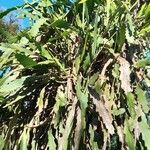the perianth tube about 18-25 cm. long, narrowly tubular, about 3 mm. in di-ameter at the base, abruptly dilated into an extremely short conic throat about 8 mm. broad at the orifice, bearing very few distant and inconspicuous external bracts, the perianth segments very narrowly oblong-elliptic, acuminate, spreading, the inner about 3-4 cm. long, the ovary oblongoid, inconspicuously tuberculate. Berry oblong-turbinate, truncate, somewhat tuberculate-angulate, about 7-8 cm. long and 2 cm. broad, bright red when ripe.
A succulent cactus. It grows attached to other plants but not feeding off them. The stems are flattened and branching. There are some aerial roots. Older plants have some spines. The flowers are tube shaped and occur singly. They open and night. The flowers have a scent. The fruit are narrowly oval. They are reddish-green and have an irregular surface. The sweet pulp has very small black seeds amongst it.
For treatment of taxon occurring in Australia see Epiphyllum phyllanthus var. hookeri (Haw.) Kimnach.









